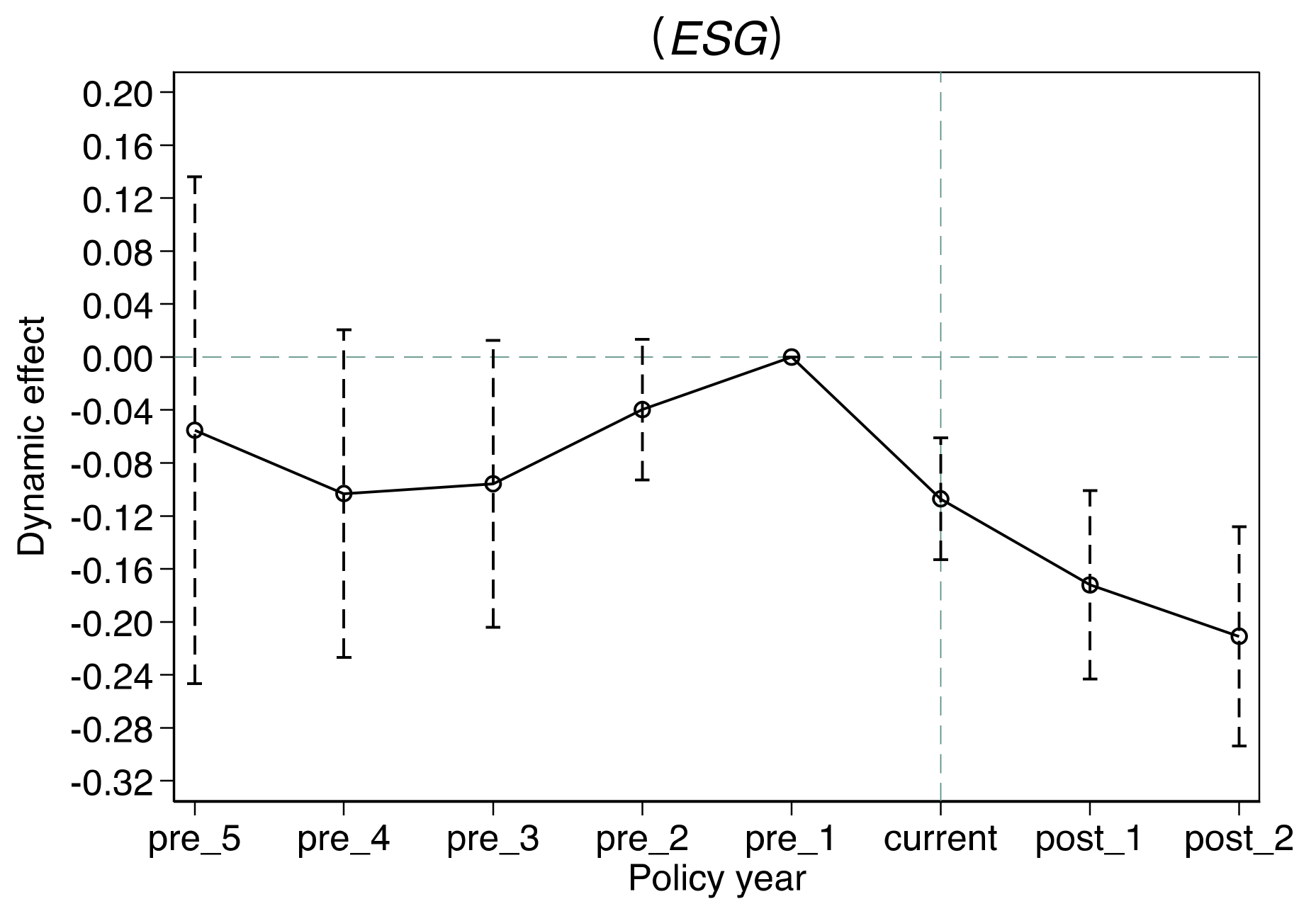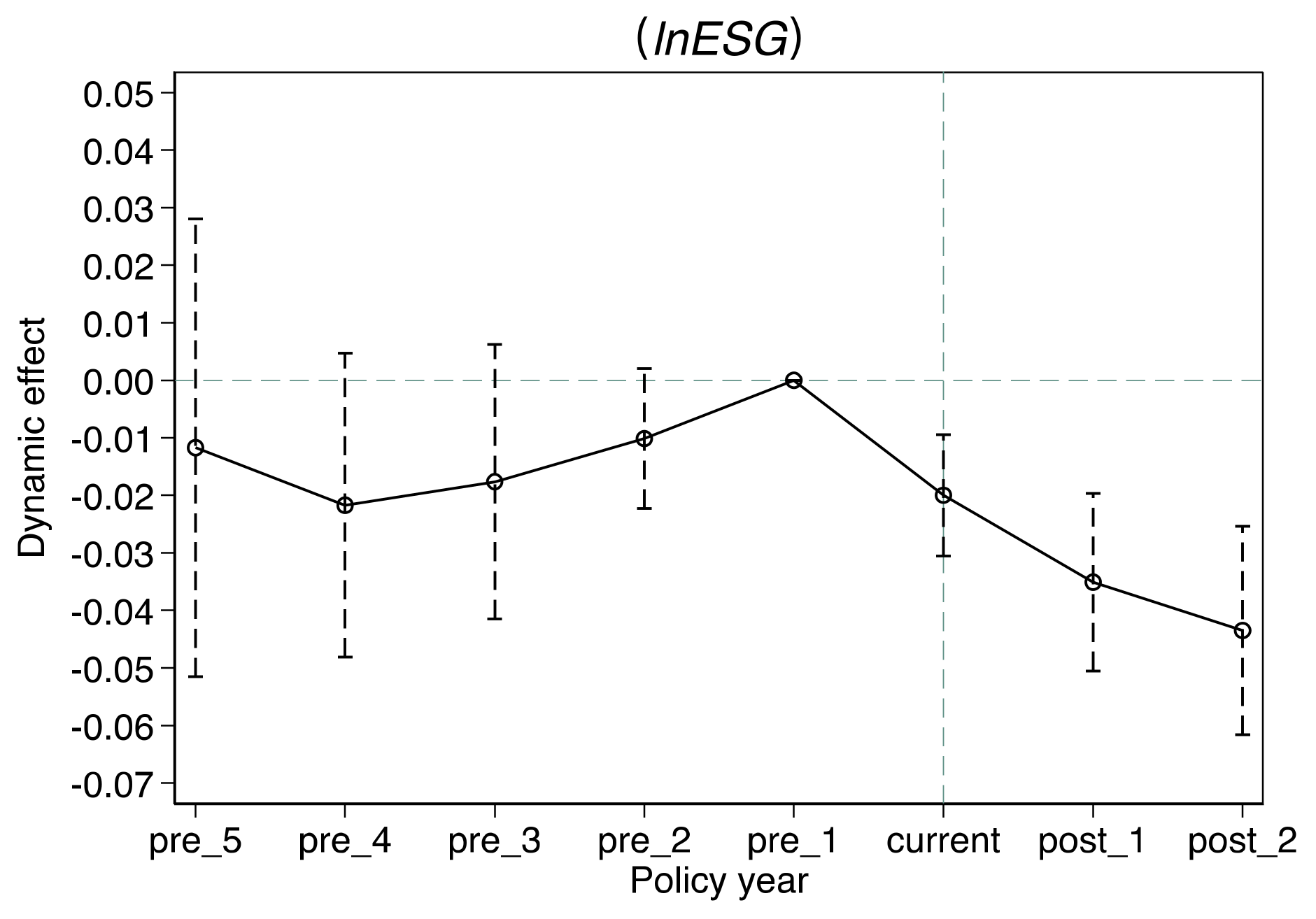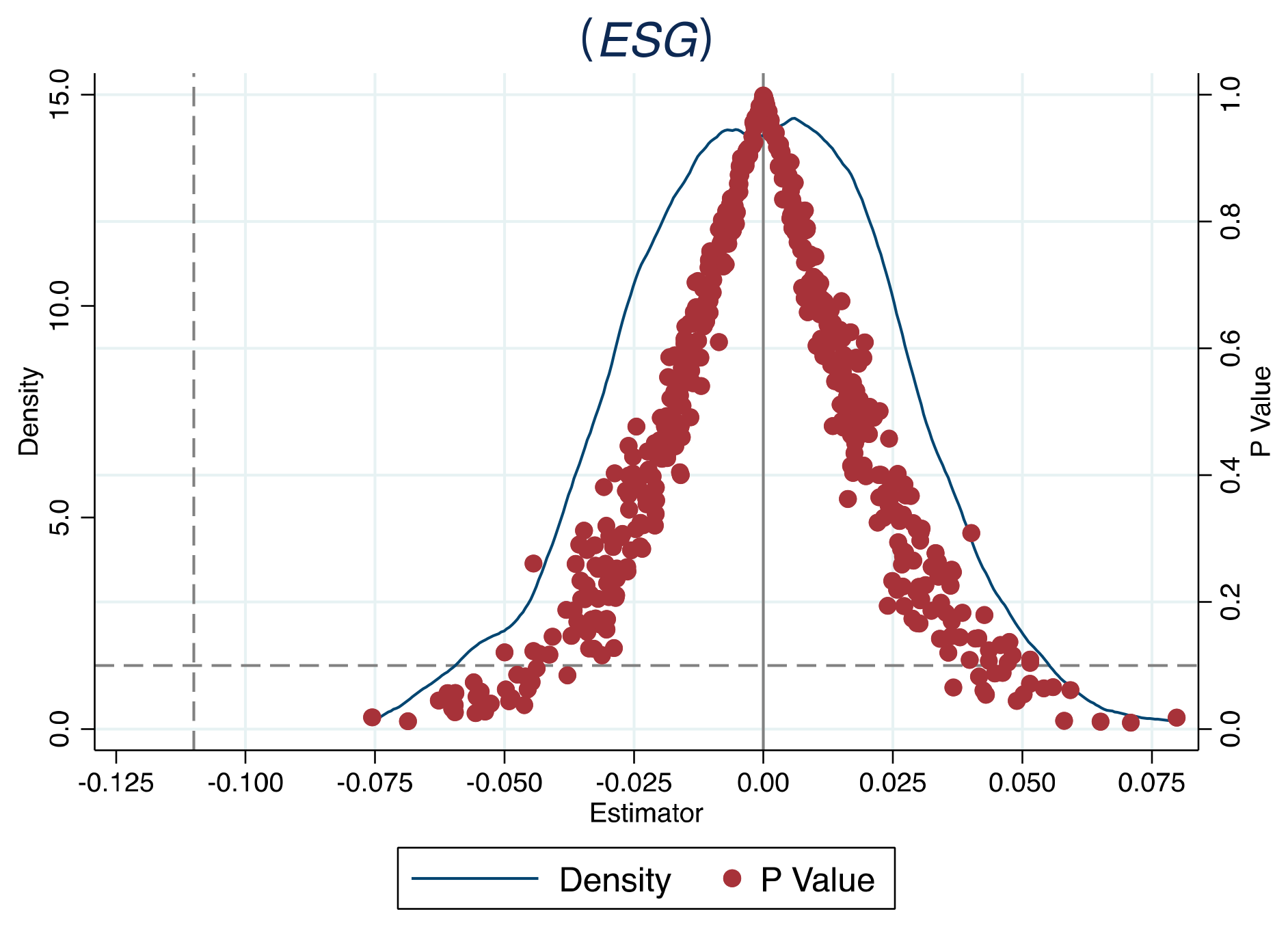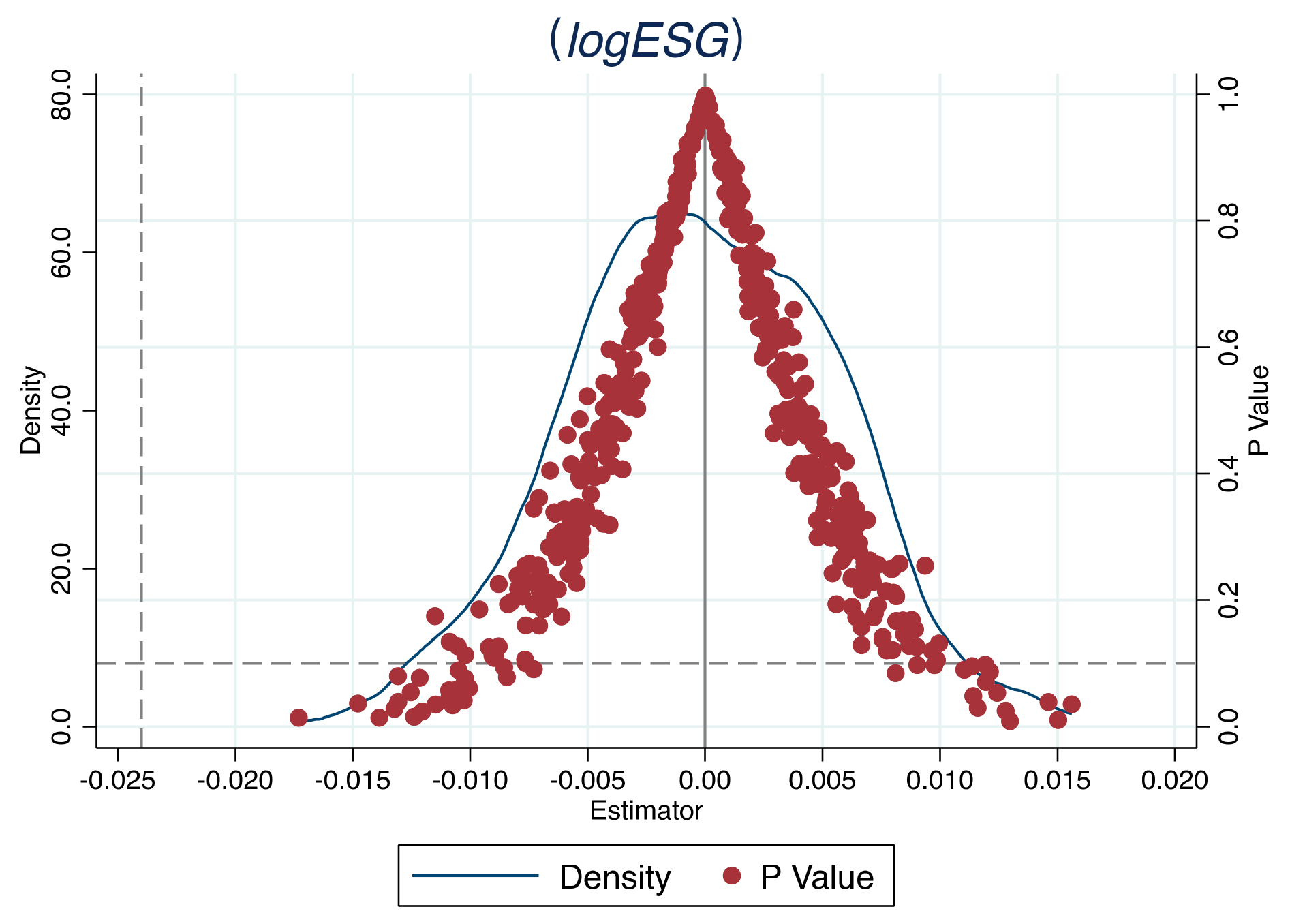Green Fiscal Policy and ESG Performance: Evidence from the Energy-Saving and Emission-Reduction Policy in China
Abstract
1. Introduction
2. Background and Hypotheses
2.1. Policy Background
2.2. Theoretical Hypotheses
2.2.1. Impact of the ESER Policy on ESG Performance
2.2.2. Incentive Effect of the ESER Policy on E Performance
2.2.3. Crowding-Out Effect of the ESER Policy on S Performance
2.2.4. Spill-Over Effect of the ESER Policy on G Performance
3. Materials and Methods
3.1. Estimation Framework
3.2. Data and Variables
3.2.1. Measures of ESG Performance
3.2.2. Measures of the ESER Policy
3.2.3. Control Variables
4. Results
4.1. Baseline Estimates
4.2. Robustness Checks
4.2.1. Parallel Trend Test
4.2.2. Placebo Test
4.2.3. Event Study
4.2.4. Discussion on Heterogeneous Treatment Effects
4.3. Further Analysis
4.4. Machanisms
4.5. Heterogeneous Effects
4.5.1. Heterogeneous Analysis of Firm-Level Characteristics
4.5.2. Heterogeneous Analysis of City-Level Characteristics
4.6. Summary
5. Conclusions
Author Contributions
Funding
Data Availability Statement
Conflicts of Interest
References
- Leins, S. ‘Responsible investment’: ESG and the Post-crisis Ethical Order. Econ. Soc. 2020, 49, 71–91. [Google Scholar] [CrossRef]
- Acemoglu, D.; Aghion, P.; Bursztyn, L.; Hemous, D. The Environment and Directed Technical Change. Am. Econ. Rev. 2012, 102, 131–166. [Google Scholar] [CrossRef] [PubMed]
- Aghion, P.; Dechezleprêtre, A.; Hémous, D.; Martin, R.; Van Reenen, J. Carbon Taxes, Path Dependency, and Directed Technical Change: Evidence from the Auto Industry. J. Pol. Econ. 2016, 124, 1–51. [Google Scholar] [CrossRef]
- Hanna, R.; Victor, D.G. Marking the Decarbonization Revolutions. Nat. Energy 2021, 6, 568–571. [Google Scholar] [CrossRef]
- Dong, F.; Liu, Y. Policy Evolution and Effect Evaluation of New-Energy Vehicle Industry in China. Resour. Policy 2020, 67, 101655. [Google Scholar] [CrossRef]
- Wang, Z.; Qiu, S. Can “Energy Saving and Emission Reduction” Demonstration City Selection Actually Contribute to Pollution Abatement in China? Sustain. Prod. Consum. 2021, 27, 1882–1902. [Google Scholar] [CrossRef]
- Xu, T.; Kang, C.; Zhang, H. China’s Efforts Towards Carbon Neutrality: Does Energy-Saving and Emission-Reduction Policy Mitigate Carbon Emissions? J. Environ. Manag. 2022, 316, 115286. [Google Scholar] [CrossRef]
- Lin, B.; Zhu, J. Impact of Energy Saving and Emission Reduction Policy on Urban Sustainable Development: Empirical Evidence from China. Appl. Energy 2019, 239, 12–22. [Google Scholar] [CrossRef]
- Galbreath, J. ESG in Focus: The Australian Evidence. J. Bus. Ethics 2013, 118, 529–541. [Google Scholar] [CrossRef]
- Baldini, M.; Maso, L.D.; Liberatore, G.; Mazzi, F.; Terzani, S. Role of Country- and Firm-Level Determinants in Environmental, Social, and Governance Disclosure. J. Bus. Ethics 2018, 150, 79–98. [Google Scholar] [CrossRef]
- Friede, G.; Busch, T.; Bassen, A. ESG and Financial Performance: Aggregated Evidence from More than 2000 Empirical Studies. J. Sustain. Fin. Investig. 2015, 5, 210–233. [Google Scholar] [CrossRef]
- Darrell, W.; Schwartz, B.N. Environmental Disclosures and Public Policy Pressure. J. Acc. Public Policy 1997, 16, 125–154. [Google Scholar] [CrossRef]
- Clarkson, P.M.; Li, Y.; Richardson, G.D.; Vasvari, F.P. Revisiting the Relation between Environmental Performance and Environmental Disclosure: An Empirical Analysis. Acc. Organ. Soc. 2008, 33, 303–327. [Google Scholar] [CrossRef]
- Zhang, C.; Zhou, B. Where Should the Money Go? The Green Effect of Governmental Guidance When Sustainable Finance Impacts Brown Firms. Pacific-Basin Fin. J. 2023, 78, 101961. [Google Scholar] [CrossRef]
- Lai, H.; Wang, F.; Guo, C. Can Environmental awards Stimulate Corporate Green Technology Innovation? Evidence from Chinese Listed Companies. Environ. Sci. Pollut. Res. 2022, 29, 14856–14870. [Google Scholar] [CrossRef]
- Song, M.; Wang, S.; Zhang, H. Could Environmental Regulation and R&D Tax Incentives Affect Green Product Innovation? J. Clean. Prod. 2020, 258, 120849. [Google Scholar] [CrossRef]
- El Ghoul, S.; Guedhami, O.; Kwok, C.C.Y.; Mishra, D.R. Does Corporate Social Responsibility Affect the Cost of Capital? J. Bank. Fin. 2011, 35, 2388–2406. [Google Scholar] [CrossRef]
- Christensen, H.B.; Hail, L.; Leuz, C. Mandatory CSR and Sustainability Reporting: Economic Analysis and Literature Review. Rev. Acc. Stud. 2021, 26, 1176–1248. [Google Scholar] [CrossRef]
- Aupperle, K.E.; Carroll, A.B.; Hatfield, J.D. An Empirical Examination of the Relationship between Corporate Social Responsibility and Profitability. Acad. Manag. J. 1985, 28, 446–463. [Google Scholar] [CrossRef]
- Chen, Y.C.; Hung, M.; Wang, Y. The Effect of Mandatory CSR Disclosure on Firm Profitability and Social Externalities: Evidence from China. J. Acc. Econ. 2018, 65, 169–190. [Google Scholar] [CrossRef]
- Aras, G.; Crowther, D. Governance and Sustainability: An Investigation into the Relationship between Corporate Governance and Corporate Sustainability. Manag. Decis. 2008, 46, 433–448. [Google Scholar] [CrossRef]
- Atan, R.; Alam, M.M.; Said, J.; Zamri, M. The Impacts of Environmental, Social, and Governance Factors on Firm Performance: Panel Study of Malaysian Companies. MEQ 2018, 29, 182–194. [Google Scholar] [CrossRef]
- Miralles-Quirós, M.M.; Miralles-Quirós, J.L.; Valente Gonçalves, L.M. The Value Relevance of Environmental, Social, and Governance Performance: The Brazilian Case. Sustainability 2018, 10, 574. [Google Scholar] [CrossRef]
- Pablo-Romero, M.D.P.; De Jesús, J. Economic Growth and Energy Consumption: The Energy-Environmental Kuznets Curve for Latin America and the Caribbean. Renew. Sustain. Energy Rev. 2016, 60, 1343–1350. [Google Scholar] [CrossRef]
- Yue, L.; Xue, D.; Draz, M.U.; Ahmad, F.; Li, J.; Shahzad, F.; Ali, S. The Double-Edged Sword of Urbanization and Its Nexus with Eco-efficiency in China. Int. J. Environ. Res. Public Health 2020, 17, 446. [Google Scholar] [CrossRef]
- Cheng, Z.; Li, L.; Liu, J. The Emissions Reduction Effect and Technical Progress Effect of Environmental Regulation Policy Tools. J. Clean. Prod. 2017, 149, 191–205. [Google Scholar] [CrossRef]
- Wu, J.; Lv, L.; Sun, J.; Ji, X. A Comprehensive Analysis of China’s Regional Energy Saving and Emission Reduction Efficiency: From Production and Treatment Perspectives. Energy Policy 2015, 84, 166–176. [Google Scholar] [CrossRef]
- Jin, H.; Yang, J.; Chen, Y. Energy Saving and Emission Reduction Fiscal Policy and Corporate Green Technology Innovation. Front. Psychol. 2022, 13, 1056038. [Google Scholar] [CrossRef]
- Yao, Y.; Jiao, J.; Han, X.; Wang, C. Can Constraint Targets Facilitate Industrial Green Production Performance in China? Energy-Saving Target vs Emission-Reduction Target. J. Clean. Prod. 2019, 209, 862–875. [Google Scholar] [CrossRef]
- Tu, Z.; Hu, T.; Shen, R. Evaluating Public Participation Impact on Environmental Protection and Ecological Efficiency in China: Evidence from PITI Disclosure. China Econ. Rev. 2019, 55, 111–123. [Google Scholar] [CrossRef]
- Yang, Z.; Fan, M.; Shao, S.; Yang, L. Does Carbon Intensity Constraint Policy Improve Industrial Green Production Performance in China? A Quasi-DID Analysis. Energy Econ. 2017, 68, 271–282. [Google Scholar] [CrossRef]
- Shao, S.; Yang, Z.; Yang, L.; Ma, S. Can China’s Energy Intensity Constraint Policy Promote Total Factor Energy Efficiency? Evidence from the Industrial Sector. Energy J. 2019, 40, 101–128. [Google Scholar] [CrossRef]
- Yu, Y.; Zhang, N. Low-Carbon City Pilot and Carbon Emission Efficiency: Quasi-Experimental Evidence from China. Energy Econ. 2021, 96, 105125. [Google Scholar] [CrossRef]
- Aaronson, D.; Agarwal, S.; French, E. The Spending and Debt Response to Minimum Wage Hikes. Am. Econ. Rev. 2012, 102, 3111–3139. [Google Scholar] [CrossRef]
- Chaney, T.; Sraer, D.; Thesmar, D. The Collateral Channel: How Real Estate Shocks Affect Corporate Investment. Am. Econ. Rev. 2012, 102, 2381–2409. [Google Scholar] [CrossRef]
- Callaway, B.; Sant’Anna, P.H.C. Difference-in-Differences with Multiple Time Periods. J. Econ. 2021, 225, 200–230. [Google Scholar] [CrossRef]
- Goodman-Bacon, A. Difference-in-Differences with Variation in Treatment Timing. J. Econ. 2021, 225, 254–277. [Google Scholar] [CrossRef]
- De Chaisemartin, C.; D’Haultfœuille, X. Two-Way Fixed Effects Estimators with Heterogeneous Treatment Effects. Am. Econ. Rev. 2020, 110, 2964–2996. [Google Scholar] [CrossRef]
- BP. Statistical Review of World Energy; BP: London, UK, 2021. [Google Scholar]
- Drempetic, S.; Klein, C.; Zwergel, B. The Influence of Firm Size on the ESG Score: Corporate Sustainability Ratings under Review. J. Bus. Ethics 2020, 167, 333–360. [Google Scholar] [CrossRef]
- Yu, E.P.Y.; Van Luu, B.V. International Variations in ESG Disclosure—Do Cross-Listed Companies Care More? Int. Rev. Financ. Anal. 2021, 75, 101731. [Google Scholar] [CrossRef]
- Attig, N.; Boubakri, N.; El Ghoul, S.; Guedhami, O. Firm Internationalization and Corporate Social Responsibility. J. Bus. Ethics 2016, 134, 171–197. [Google Scholar] [CrossRef]
- Tamimi, N.; Sebastianelli, R. Transparency among S&P 500 Companies: An Analysis of ESG Disclosure Scores. Manag. Decis. 2017, 55, 1660–1680. [Google Scholar] [CrossRef]
- Hegde, S.P.; Mishra, D.R. Married CEOs and Corporate Social Responsibility. J. Corp. Fin. 2019, 58, 226–246. [Google Scholar] [CrossRef]
- Aabo, T.; Giorici, I.C. Do Female CEOs Matter for ESG Scores? Glob. Fin. J. 2022, in press. [Google Scholar] [CrossRef]
- Daft, R.L.; Sormunen, J.; Parks, D. Chief Executive Scanning, Environmental Characteristics, and Company Performance: An Empirical Study. Strat. Mgmt J. 1988, 9, 123–139. [Google Scholar] [CrossRef]
- Viscusi, W.K. Frameworks for Analyzing the Effects of Risk and Environmental Regulations on Productivity. Am. Econ. Rev. 1983, 73, 793–801. [Google Scholar]
- Balachandran, B.; Nguyen, J.H. Does Carbon Risk Matter in Firm Dividend Policy? Evidence from a Quasi-Natural Experiment in an Imputation Environment. J. Bank. Fin. 2018, 96, 249–267. [Google Scholar] [CrossRef]
- Kabir, M.N.; Rahman, S.; Rahman, M.A.; Anwar, M. Carbon Emissions and Default Risk: International Evidence from Firm-Level Data. Econ. Model. 2021, 103, 105617. [Google Scholar] [CrossRef]
- Porter, M.E.; Linde, C. Toward a New Conception of the Environment-Competitiveness Relationship. J. Econ. Perspect. 1995, 9, 97–118. [Google Scholar] [CrossRef]
- He, F.; Du, H.; Yu, B. Corporate ESG Performance and Manager Misconduct: Evidence from China. Int. Rev. Financ. Anal. 2022, 82, 102201. [Google Scholar] [CrossRef]
- Zumente, I.; Bistrova, J. ESG Importance for Long-Term Shareholder Value Creation: Literature vs. Practice. J. Open Innov. Technol. Mark. Complex. 2021, 7, 127. [Google Scholar] [CrossRef]
- Kitzmueller, M.; Shimshack, J. Economic Perspectives on Corporate Social Responsibility. J. Econ. Lit. 2012, 50, 51–84. [Google Scholar] [CrossRef]
- Freise, A.; Link, S.; Mayer, S. Taxation and Corporate Governance—The State of the Art. In Tax and Corporate Governance; Schön, W., Ed.; Springer: Berlin/Heidelberg, Germany, 2008. [Google Scholar]
- Freedman, J. Tax and Corporate Responsibility. Tax J. 2003, 695, 1–4. [Google Scholar]
- Slemrod, J. The Economics of Corporate Tax Selfishness. Natl. Tax J. 2004, 57, 877–899. [Google Scholar] [CrossRef]
- Williams, D.F. Developing the Concept of Tax Governance; KPMG: London, UK, 2007; p. 16. [Google Scholar]
- Lanis, R.; Richardson, G. Corporate Social Responsibility and Tax Aggressiveness: An Empirical Analysis. J. Acc. Public Policy 2012, 31, 86–108. [Google Scholar] [CrossRef]
- Christensen, J.; Murphy, R. The Social Irresponsibility of Corporate Tax Avoidance: Taking CSR to the Bottom Line. Development 2004, 47, 37–44. [Google Scholar] [CrossRef]
- Hambrick, D.C. Upper Echelons Theory: An Update. Acad. Manag. Rev. 2007, 32, 334–343. [Google Scholar] [CrossRef]
- Hambrick, D.C.; Mason, P.A. Upper Echelons: The Organization as a Reflection of Its Top Managers. Acad. Manag. Rev. 1984, 9, 193–206. [Google Scholar] [CrossRef]
- Delmas, M.; Toffel, M.W. Stakeholders and Environmental Management Practices: An Institutional Framework. Bus. Strategy Environ. 2004, 13, 209–222. [Google Scholar] [CrossRef]
- Zhang, B.; Wang, Z.; Lai, K.H. Mediating Effect of Managers’ Environmental Concern: Bridge between External Pressures and Firms’ Practices of Energy Conservation in China. J. Environ. Psychol. 2015, 43, 203–215. [Google Scholar] [CrossRef]
- Li, J.; Lian, G.; Xu, A. How Do ESG Affect the Spillover of Green Innovation among Peer Firms? Mechanism Discussion and Performance Study. J. Bus. Res. 2023, 158, 113648. [Google Scholar] [CrossRef]
- Tan, X.; Choi, Y.; Wang, B.; Huang, X. Does China’s Carbon Regulatory Policy Improve Total Factor Carbon Efficiency? A Fixed-Effect Panel Stochastic Frontier Analysis. Technol. Forecast. Soc. Chang. 2020, 160, 120222. [Google Scholar] [CrossRef]
- Luo, C.; Wei, D.; He, F. Corporate ESG Performance and Trade Credit Financing—Evidence from China. Int. Rev. Econ. Fin. 2023, 85, 337–351. [Google Scholar] [CrossRef]
- Shu, H.; Tan, W. Does Carbon Control Policy Risk Affect Corporate ESG Performance? Econ. Modell. 2023, 120, 106148. [Google Scholar] [CrossRef]
- Beck, T.; Levine, R.; Levkov, A. Big Bad Banks? The Winners and Losers from Bank Deregulation in the United States. J. Fin. 2010, 65, 1637–1667. [Google Scholar] [CrossRef]
- Wang, H.Q.; Zhang, Y. Trade Structure Upgrading, Environmental Regulation and Green Technology Innovation in Different Regions of China. China Soft Sci. 2020, 2, 174–181. [Google Scholar]
- Ruan, F.; Yan, L.; Wang, D. The Complexity for the Resource-Based Cities in China on Creating Sustainable Development. Cities 2020, 97, 102571. [Google Scholar] [CrossRef]
- Shao, S.; Zhang, Y.; Tian, Z.; Li, D.; Yang, L. The Regional Dutch Disease Effect Within China: A Spatial Econometric Investigation. Energy Econ. 2020, 88, 104766. [Google Scholar] [CrossRef]




| Batch | Announcement Period | Subsidy Period | Cities |
|---|---|---|---|
| 1 | 2011 | 2012–2014 | Beijing, Shenzhen, Chongqing, Hangzhou, Changsha, Guiyang, Jilin, Xinyu |
| 2 | 2013 | 2014–2016 | Shijiazhuang, Tangshan, Tieling, Qiqihaer, Tongling, Nanping, Jingmen, Shaoguan, Dongguan, Tongchuan |
| 3 | 2014 | 2015–2017 | Tianjin, Linfen, Baotou, Xuzhou, Liaocheng, Hebi, Meizhou, Nanning, Deyang, Lanzhou, Wulumuqi |
| Type | Variable Name | Symbol | Definition |
|---|---|---|---|
| Independent variable | ESG performance | ESG | The score of the SSIS ESG rating |
| E performance | Eper | The score of energy saving and emission reduction from Hexun.com | |
| S performance | Sper | The score of social responsibility from Hexun.com | |
| G performance | Gper | The score of the environmental information disclosure carrier from the CSMAR database | |
| Dependent variable | ESER policy | Policy | =1 if the enterprise is in a pilot city that obtains a subsidy from the central government in year t, and 0 otherwise |
| Control variable | Firm size | scale | Logarithm of total assets |
| Leverage | lev | Total debt to assets ratio | |
| Return on assets | roa | Return on assets | |
| Operating income growth | growth | Operating income in the current year to the previous year | |
| Total Asset Turnover | tat | Total asset turnover | |
| Equity concentration | top | Proportion of the largest shareholder | |
| Proportion of institutional investors | institute | Proportion of institutional investors |
| Variables | Obs | Mean | SD | Min | Median | Max |
|---|---|---|---|---|---|---|
| ESG | 10,536 | 3.941 | 0.976 | 1.000 | 4.000 | 6.750 |
| Eper | 10,529 | 1.554 | 3.622 | 0.000 | 0.000 | 14.000 |
| Sper | 10,530 | 4.343 | 4.193 | −15.000 | 4.100 | 30.000 |
| Gper | 10,536 | 1.012 | 0.671 | 0.000 | 1.000 | 3.000 |
| Policy | 10,536 | 0.083 | 0.277 | 0.000 | 0.000 | 1.000 |
| scale | 10,533 | 22.069 | 1.224 | 18.353 | 21.981 | 25.693 |
| lev | 10,535 | 46.669 | 23.329 | 3.176 | 45.924 | 218.634 |
| roa | 10,536 | 3.992 | 6.093 | −20.830 | 3.449 | 28.133 |
| growth | 10,523 | 15.631 | 35.123 | −61.709 | 10.851 | 279.508 |
| institute | 10,411 | 41.281 | 22.037 | 0.360 | 42.621 | 88.325 |
| top | 10,536 | 34.055 | 14.798 | 8.420 | 32.055 | 75.000 |
| tat | 10,528 | 0.713 | 0.498 | 0.043 | 0.599 | 3.190 |
| ESG | logESG | |||
|---|---|---|---|---|
| (1) | (2) | (3) | (4) | |
| Policy | −0.1283 *** | −0.1101 *** | −0.0250 *** | −0.0200 *** |
| (−3.73) | (−3.29) | (−3.26) | (−2.70) | |
| Controls | No | Yes | No | Yes |
| Constant | 3.9555 *** | −0.8478 | 1.5784 *** | −0.4084 ** |
| (1293.89) | (−1.38) | (2311.91) | (2.57) | |
| Observations | 9900 | 9758 | 9900 | 9758 |
| R-squared | 0.665 | 0.677 | 0.637 | 0.651 |
| Firm fixed effect | Yes | Yes | Yes | Yes |
| Year fixed effect | Yes | Yes | Yes | Yes |
| ESG | logESG | |
|---|---|---|
| ESER(−5) | −0.0725 (−0.53) | −0.0176 (−0.64) |
| ESER(−4) | −0.1086 (−1.25) | −0.0240 (−1.31) |
| ESER(−3) | −0.1068 (−1.35) | −0.0210 (−1.23) |
| ESER(−2) | −0.0396 (−1.24) | −0.0102 (−1.40) |
| ESER(0) | −0.1104 *** (−4.22) | −0.0206 *** (−3.44) |
| ESER(1) | −0.1772 *** (−4.02) | −0.0363 *** (−3.81) |
| ESER(2) | −0.2048 *** (−4.38) | −0.0421 *** (−4.16) |
| Controls | Yes | Yes |
| Observations | 9900 | 9900 |
| R-squared | 0.6652 | 0.6373 |
| Sample | 2010–2020 | |
|---|---|---|
| Variables | ESG | logESG |
| Negative weight | 0.00% | 0.00% |
| Average treatment effect | −0.1670 | −0.0336 |
| Variables | E Performance | S Performance | G Performance | |||
|---|---|---|---|---|---|---|
| (1) | (2) | (3) | (4) | (5) | (6) | |
| Policy | 0.3437 *** | 0.3477 ** | −0.3408 ** | −0.3343 ** | 0.0878 *** | 0.0874 *** |
| (2.67) | (2.58) | (−2.20) | (−2.09) | (3.22) | (3.11) | |
| Controls | No | Yes | No | Yes | No | Yes |
| Constant | 1.5598 *** | −7.5481 *** | 4.3818 *** | −11.6482 *** | 0.9967 *** | −1.2324 *** |
| Observations | 9893 | 9751 | 9894 | 9752 | 9900 | 9758 |
| R-squared | 0.572 | 0.577 | 0.477 | 0.505 | 0.622 | 0.627 |
| Firm fixed effect | Yes | Yes | Yes | Yes | Yes | Yes |
| Year fixed effect | Yes | Yes | Yes | Yes | Yes | Yes |
| E Performance | ||||
|---|---|---|---|---|
| J Utility | J Inven | I Utility | I Inven | |
| (1) | (2) | (3) | (4) | |
| Policy | 0.0269 ** | 0.0014 | 0.0139 | 0.0191 |
| (2.42) | (0.20) | (0.55) | (0.95) | |
| Controls | Yes | Yes | Yes | Yes |
| Constant | −0.3191 *** | −0.0630 | −0.2327 | −0.3389 |
| (−2.80) | (−0.56) | (−0.86) | (−1.46) | |
| Observations | 9758 | 9758 | 9758 | 9758 |
| R-squared | 0.576 | 0.543 | 0.657 | 0.594 |
| Firm fixed effect | Yes | Yes | Yes | Yes |
| Year fixed effect | Yes | Yes | Yes | Yes |
| E Performance | S Performance | G Performance | ||
| Media | Tax | Donation | Awareness | |
| (5) | (6) | (7) | (8) | |
| Policy | 0.0993 * | −0.1328 *** | −0.0293 | 0.0323 * |
| (1.91) | (−3.21) | (−0.35) | (1.85) | |
| Controls | Yes | Yes | Yes | Yes |
| Constant | 1.3588 | −0.9829 | −2.0837 *** | −1.1440 *** |
| (1.56) | (−1.12) | (−3.09) | (−4.65) | |
| Observations | 9730 | 8838 | 9758 | 9751 |
| R-squared | 0.643 | 0.466 | 0.562 | 0.609 |
| Firm fixed effect | Yes | Yes | Yes | Yes |
| Year fixed effect | Yes | Yes | Yes | Yes |
| Type | ||||
|---|---|---|---|---|
| SOEs | Non-SOEs | |||
| ESG | logESG | ESG | logESG | |
| (1) | (2) | (3) | (4) | |
| −0.0376 | −0.0036 | −0.1725 *** | −0.0342 *** | |
| (−0.53) | (−0.23) | (−4.23) | (−3.64) | |
| Constant | 0.5013 | 0.502 ** | −1.3269 | 0.2928 |
| (−0.59) | (2.34) | (−1.58) | (1.41) | |
| Controls | Yes | Yes | Yes | Yes |
| Observations | 4755 | 4755 | 5003 | 5003 |
| R-squared | 0.668 | 0.643 | 0.687 | 0.660 |
| Firm fixed effect | Yes | Yes | Yes | Yes |
| Year fixed effect | Yes | Yes | Yes | Yes |
| Industry | ||||
| Pollute | Non-Pollute | |||
| ESG | logESG | ESG | logESG | |
| (5) | (6) | (7) | (8) | |
| −0.1483 *** | −0.0266 ** | −0.0909 ** | −0.0169 * | |
| (−3.09) | (−2.65) | (−2.10) | (−1.78) | |
| Constant | −0.2508 | 0.5689 * | −1.0917 ** | 0.3266 ** |
| (−0.20) | (1.76) | (−1.74) | (2.01) | |
| Controls | Yes | Yes | Yes | Yes |
| Observations | 3698 | 3698 | 6060 | 6060 |
| R-squared | 0.661 | 0.636 | 0.686 | 0.661 |
| Firm fixed effect | Yes | Yes | Yes | Yes |
| Year fixed effect | Yes | Yes | Yes | Yes |
| Environmental Concern | ||||
|---|---|---|---|---|
| High Environmental Concern | Low Environmental Concern | |||
| ESG | logESG | ESG | logESG | |
| (1) | (2) | (3) | (4) | |
| −0.1213 *** | −0.0213 *** | −0.0604 | −0.0135 | |
| (−3.42) | (−2.79) | (−0.50) | (−0.48) | |
| Controls | Yes | Yes | Yes | Yes |
| Constant | −0.2355 | 0.5675 ** | −2.1831 *** | 0.0958 |
| (−0.28) | (2.50) | (−3.19) | (0.57) | |
| Observations | 6024 | 6024 | 3556 | 3556 |
| R-squared | 0.720 | 0.702 | 0.722 | 0.695 |
| Firm fixed effect | Yes | Yes | Yes | Yes |
| Year fixed effect | Yes | Yes | Yes | Yes |
| Resource Endowment | ||||
| Resource-Based Cities | Non-Resource-Based Cities | |||
| ESG | logESG | ESG | logESG | |
| (5) | (6) | (7) | (8) | |
| Policy | −0.0658 | −0.0035 | −0.1160 *** | −0.0225 *** |
| (−0.73) | (−0.18) | (−3.21) | (−2.79) | |
| Controls | Yes | Yes | Yes | Yes |
| Constant | −0.7484 | 0.4620 | −0.8427 | 0.4080 ** |
| (−0.41) | (1.08) | (−1.16) | (2.12) | |
| Observations | 1529 | 1529 | 8229 | 8229 |
| R-squared | 0.673 | 0.656 | 0.678 | 0.651 |
| Firm fixed effect | Yes | Yes | Yes | Yes |
| Year fixed effect | Yes | Yes | Yes | Yes |
Disclaimer/Publisher’s Note: The statements, opinions and data contained in all publications are solely those of the individual author(s) and contributor(s) and not of MDPI and/or the editor(s). MDPI and/or the editor(s) disclaim responsibility for any injury to people or property resulting from any ideas, methods, instructions or products referred to in the content. |
© 2023 by the authors. Licensee MDPI, Basel, Switzerland. This article is an open access article distributed under the terms and conditions of the Creative Commons Attribution (CC BY) license (https://creativecommons.org/licenses/by/4.0/).
Share and Cite
Miao, S.; Tuo, Y.; Zhang, X.; Hou, X. Green Fiscal Policy and ESG Performance: Evidence from the Energy-Saving and Emission-Reduction Policy in China. Energies 2023, 16, 3667. https://doi.org/10.3390/en16093667
Miao S, Tuo Y, Zhang X, Hou X. Green Fiscal Policy and ESG Performance: Evidence from the Energy-Saving and Emission-Reduction Policy in China. Energies. 2023; 16(9):3667. https://doi.org/10.3390/en16093667
Chicago/Turabian StyleMiao, Shan, Yandi Tuo, Xi Zhang, and Xiang Hou. 2023. "Green Fiscal Policy and ESG Performance: Evidence from the Energy-Saving and Emission-Reduction Policy in China" Energies 16, no. 9: 3667. https://doi.org/10.3390/en16093667
APA StyleMiao, S., Tuo, Y., Zhang, X., & Hou, X. (2023). Green Fiscal Policy and ESG Performance: Evidence from the Energy-Saving and Emission-Reduction Policy in China. Energies, 16(9), 3667. https://doi.org/10.3390/en16093667




